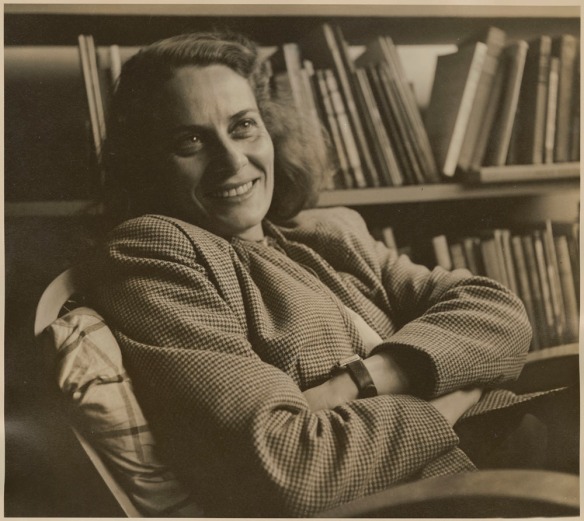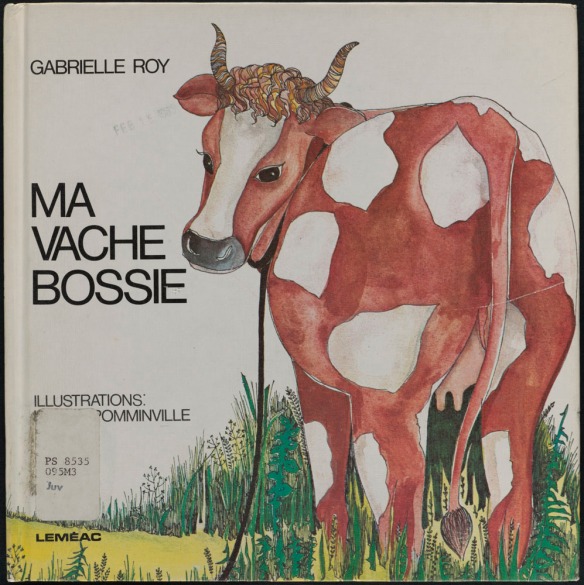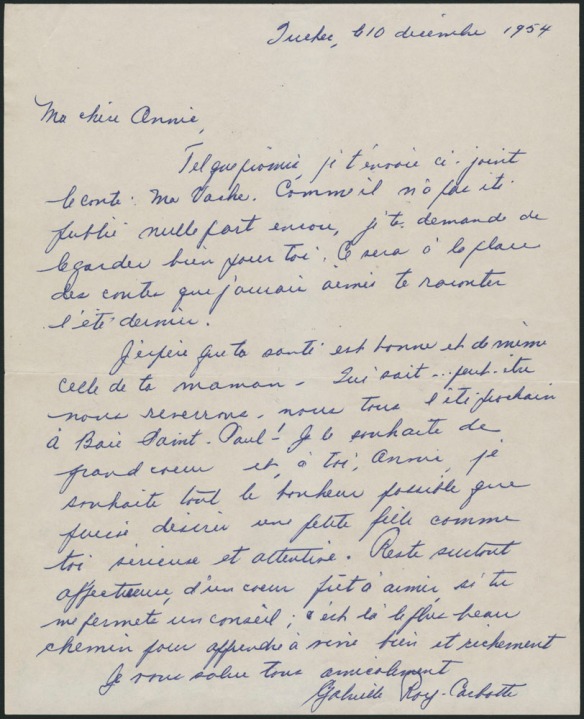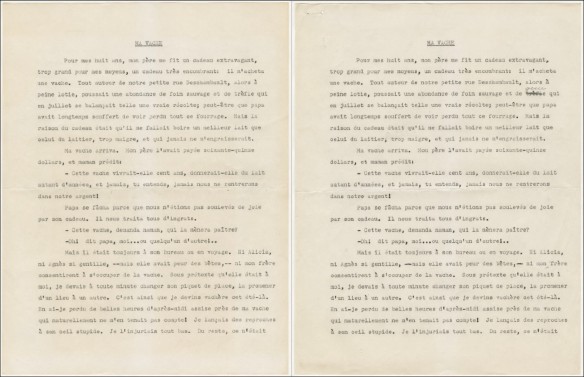By Ariane Brun del Re and Stéphane Lang
Did you know that famous novelist Gabrielle Roy, known for Bonheur d’occasion (1945) (published in English as The Tin Flute, 1947), La petite poule d’eau (1950) (published in English as Where Nests the Water Hen, 1951), and Rue Deschambault (1955) (published in English as Street of Riches, 1957) also published children’s books?

Writer Gabrielle Roy in 1946 (e010957756).
In 1976, Gabrielle Roy released Ma vache Bossie, a picture book illustrated by Louise Pomminville. It tells the story of a young girl who receives a funny birthday gift: her father gives her a cow named Bossie so that she can drink milk that’s richer than the milkman’s. But the gift, which was very expensive and cumbersome, does not please her mother. In addition to bothering the neighbours, Bossie produces so much milk that the family no longer knows what to do with it!
In the biography Gabrielle Roy, une vie (1996) (published in English as Gabrielle Roy: A Life, 1999), François Ricard explains that Gabrielle Roy wrote Ma vache Bossie around 1954, at the same time as Rue Deschambault. The text first appeared under the title “Ma vache” in the magazine Terre et Foyer in the summer of 1963. Gabrielle Roy then reworked it around 1974 to include it in Fragiles Lumières de la terre (published in English as The Fragile Lights of Earth, 1982), a book that brings together texts that had already been published elsewhere, but that had become difficult to access. In the end, Ma vache Bossie was removed from the manuscript; the story appeared instead in the form of an illustrated book published by Éditions Leméac. It was also featured in Contes pour enfants (1998), which brought together four animal stories written by Gabrielle Roy. In the meantime, the picture book was translated into English by Alan Brown and was published under the title My Cow Bossie (1988), with the same illustrations as in the French edition.

Cover of the picture book Ma vache Bossie (1976) by Gabrielle Roy, illustrated by Louise Pomminville (OCLC 299347564).
For a long time, we thought that the first edition of Ma vache Bossie, written in the 1950s, had been lost. But then we received an email from Annik Charbonneau, a retired math teacher who was nine years old when Gabrielle Roy wrote Ma vache Bossie. At that time, Annik spent her summers in the Charlevoix area, where Gabrielle Roy also visited. The great writer and the young girl met at the Belle Plage hotel, where Gabrielle Roy and her husband sometimes dined. The owners were friends of Annik’s parents, Fernand Charbonneau and Francine Grignon-Charbonneau.
It was following these meetings that Gabrielle Roy offered the typescript of Ma vache Bossie to young Annik. In the accompanying handwritten letter dated December 10, 1954, the writer explains that she gave Annik this story [translation] “as promised,” “in place of the tales [she would have] liked to tell [her] last summer.” The letter concludes with some valuable guidance: [translation] “Above all, remain caring, with a heart ready to love if you allow me a word of advice; that is the best way to learn to live well and richly.” Sixty-eight years later, Annik Charbonneau contacted us to have these documents preserved at Library and Archives Canada, where the Gabrielle Roy fonds is located.

Handwritten letter from Gabrielle Roy to Annie (actually Annik) Charbonneau accompanying the typescript of Ma vache Bossie (e011414002).
After receiving Annik Charbonneau’s documents, we compared them with the two typescripts of Ma vache Bossie in the Gabrielle Roy fonds, acquired by Library and Archives Canada in 1982. The archivist in charge of the collection at the time determined that both documents were likely written around 1970. We discovered, however, that the first of the two typescripts was identical to Annik Charbonneau’s: it was a carbon copy of the one she had given us (or vice versa).

Two typescripts of Ma vache Bossie. The one on the left was a gift to Annik Charbonneau, while the writer kept the one on the right. The first is part of the Annik Charbonneau collection on Gabrielle Roy, and the second is part of the Gabrielle Roy fonds (e011414003 and e011414004).
Thanks to the accompanying letter from Gabrielle Roy, we were finally able to correctly date the typescript in our possession. Annik Charbonneau’s donation also revealed that Gabrielle Roy sometimes typed two copies of the same text, inserting a carbon sheet between two sheets of paper. What distinguishes the two typescripts are Gabrielle Roy’s handwritten annotations, which are more numerous in the copy she kept than in the one given to Annik Charbonneau, where she simply corrects typos or adds a missing word. The last page of Annik Charbonneau’s typescript bears Gabrielle Roy’s signature, showing her concern to authenticate it before giving it away. In this way, new acquisitions sometimes provide us with contextual elements to better understand the documents already in our collection.
Today, the two typescripts are finally reunited at Library and Archives Canada, but not in the same fonds. The one we recently acquired is part of the Annik Charbonneau collection on Gabrielle Roy. In addition to the typescript and the letter, this collection includes two books by Gabrielle Roy dedicated to Francine G. Charbonneau, as well as a handwritten note and clippings from newspapers and magazines such as Châtelaine and Madame, which were once collected in an album by Annik Charbonneau and her mother. The ensemble reflects the impression that Gabrielle Roy left on the people she encountered in Charlevoix, such as young Annik, to whom she wanted to tell stories.
Additional resources
- Gabrielle Roy: A Life, François Ricard (OCLC 39380923)
- Gabrielle Roy fonds, Library and Archives Canada (MIKAN 3672665)
Ariane Brun del Re and Stéphane Lang are French-language literature archivists with Library and Archives Canada’s Private Archives and Published Heritage Branch






